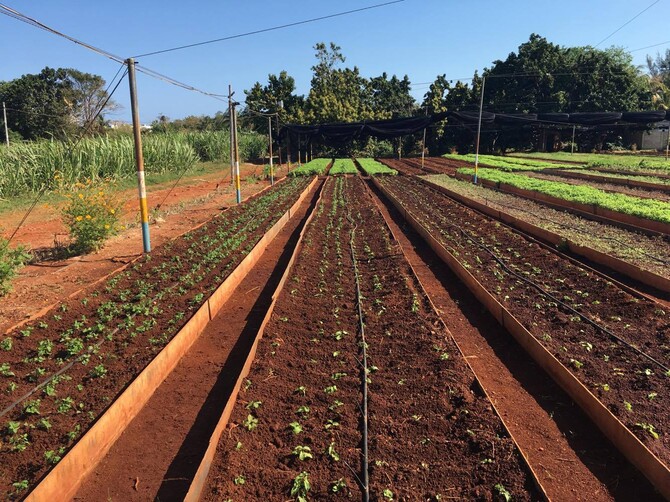Penn Researchers Look to Cuba for Sustainability and Agroecology in Practice
On many farms in the Cuban countryside, yellow flowers bookend certain crops, placed in such a way to concentrate insects there rather than on the produce growing in the rows between. Equipment-toting oxen and tractors are equally common sights, and combined with a self-sustaining water system, minimize the need to transport fuel across great distances.
In parts of Havana, the country’s capital, crops take up spaces that would otherwise be occupied by typical city blocks, 10 to 12 farms on a five-mile stretch signifying the tandem evolution of urbanization and nature and food systems.
These preliminary observations come from researchers, led by the University of Pennsylvania’s Shana Starobin, who are studying Cuba’s unique agricultural system. Their goal is to understand how farmers there adapted to a sudden disconnect from the global economy after the collapse of the former Soviet Union in the 1990s, an event that forced a rapid shift away from energy-intensive, industrial production heavily reliant on imported machinery, fossil fuels, chemical fertilizers and pesticides.
Supported by a grant from Penn’s Kleinman Center for Energy Policy, Starobin, who is a second-year post-doctoral fellow with the Penn Program on Regulation at the Law School, created the project. She was joined by undergrad Alexandra Johnson and independent researchers Anna Levy and Rachel Gordon. The end result will be a report detailing the findings that Kleinman will publish, as well as a longer-term endeavor for Starobin focusing on alternatives to transnational governance, including local, sustainable solutions to environmental challenges.
She said Cuba is a strong case study for this type of research.
“It’s largely been isolated from aspects of globalization that have affected the markets, regulations and agricultural practices of small-scale and subsistence farmers elsewhere in Latin America and around the world,” she said. “Cuba’s farmers were compelled to innovate in isolation and find their own ways to food security, including embracing agroecology, which pays close attention to the interdependence of ecosystem function and agricultural productivity.”
The country has also been heralded as one to watch in the face of climate change, Starobin added. “It has already been forced to rethink how to feed its population without a lot of external inputs, offering potential lessons to countries and communities anticipating resource scarcity.”
For this project, Johnson, a sophomore philosophy major from Washington, D.C., visited the island for a week in March. Her aim was two-fold: Check out at least one farm and analyze several food markets.
She succeeded in touring a farm called Vivero Alamar about 20 minutes outside of central Havana and well known for its sustainability practices, which uses cows and horses for a multitude of purposes. “These animals serve as a substitute for physical or manual labor,” Johnson explained. “Moreover, they had an entire section of the farm devoted to rabbits, for meat and diversified fertilizer.”
The 26-acre farm cooperative also touts its “organic” production, employing practices like the use of cover crops and crop rotation to increase produce diversity and output.
In addition to learning about farming practices, Johnson’s secondary research directive from Starobin was to understand what’s taking place internally within the country’s fresh fruit and vegetable markets, akin to U.S. farmers’ markets rather than grocery stores.
“There are markets oriented to local Cuban consumption, selling a more limited selection at subsidized prices. Other markets service restaurants and hotels catering to high-end tourists, offering premium products and prices,” Starobin said. “The shifting dynamics of Cuba’s growing tourism sector may reshape the pressures on Cuba’s food system.”
To see what they could learn about such a system, and to observe land use and agricultural practices at both rural and urban farms, Levy and Gordon spent two weeks in late March and early April traveling between five cities across Cuba.
“Cooperative and collective forms of land ownership, spared by land-grabs widely experienced in other parts of the world, are just as important for understanding and learning from Cuban food systems as the agricultural processes employed,” Levy said.
For the next phase of research, Starobin will analyze the information brought back by her team to help build a baseline for future work and collaboration with Cuban farmers. There’s a lot to contemplate, particularly as the U.S. relationship continues to change and as Cuba’s infrastructure evolves further.To that end, right now the researchers hesitate to make any blanket claims about farming and agriculture in Cuba. It’s just too early. But they are trying to interpret what they’ve seen and heard from the people with whom they’ve already interacted.
And Starobin will say this: “There’s no magic bullet for tackling food insecurity and sustainability. But successful adoption of agroecological methods in parts of Cuba suggests that there are pathways that lead to sustainability and productivity. They rely on human ingenuity, collaboration and greater knowledge of environmental systems, rather than costly investments in external inputs or other proclaimed one-size-fits-all technologies.”
The grant was one of nine the Kleinman Center for Energy Policy funded for 2016-17 to support Penn faculty research. Among other project topics are Coca Cola’s relationship with the government of Ghana, environmentally responsive buildings and the energy transition in and around the city of Philadelphia.








